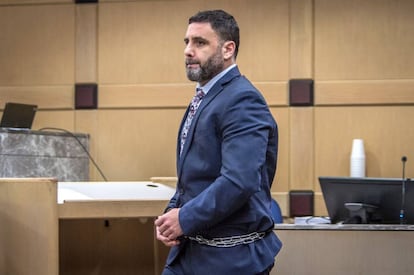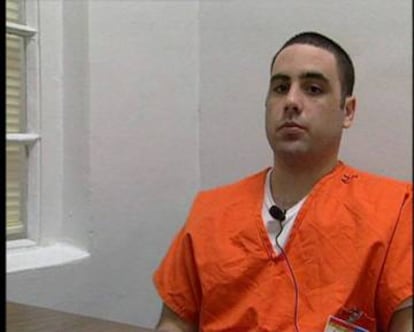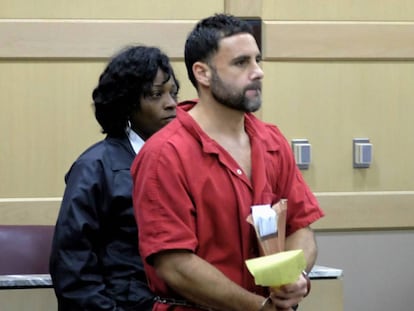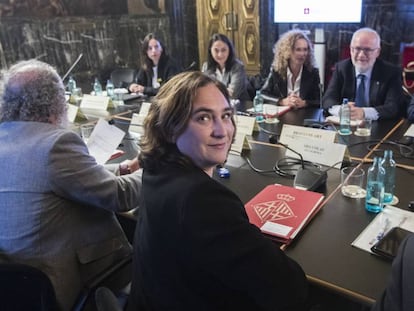Death row inmate Pablo Ibar found guilty of triple murder for a second time
A Florida jury did not explain its decision for convicting the half-Spanish defendant, who has maintained his innocence throughout three trials and 24 years spent in prison

A US jury has found death row inmate Pablo Ibar guilty of a 1994 triple killing in Florida in what is known as the “Casey’s Nickelodeon” murder case.
The eight-member jury did not provide the reasons for its decision, which confirms an earlier guilty verdict handed down in 2000. The conviction was read out on Saturday by Judge Dennis Bailey, and Ibar was taken back to prison. A sentence will be read out on February 25, with prosecutors seeking the death penalty once again.
In 2016, the Florida Supreme Court wrote that there was a lack of physical evidence connecting Ibar to the triple murders
Ibar, who is of Spanish descent on his father’s side, has been behind bars for 24 years, 16 of them on death row, for the murder of a bar owner and two dancers inside the former’s house in Broward County, Florida.
The case has been widely followed in Spain due to his father’s origins in the Basque Country. A Pablo Ibar Association was set up to lobby against the death penalty and to raise funds to pay for Ibar’s defense.
His father, Cándido Ibar, who emigrated to Florida in the 1960s to play the traditional Basque sport known as pelota, traveled to Spain last year to support a crowdfunding drive to cover his son’s legal fees, which are estimated at more than $1 million.

This latest trial marked the third for Ibar, whose first time inside a courtroom, in 1997, ended in a hung jury. He was found guilty and sentenced to death in 2000, then won a Florida Supreme Court battle to be granted a retrial on the basis that his court-appointed counsel had mounted a flawed defense.
In 2016, the Florida Supreme Court also wrote that there was a lack of physical evidence connecting Ibar to the triple murders. Ibar’s DNA was not found on a blue T-shirt recovered from the crime scene, and which partially covered the face of the perpetrator according to grainy surveillance camera footage.
No DNA evidence
No conclusive DNA evidence was ever found linking Ibar to the crime scene. Of the more than 100 fingerprints found inside the house of victim Casimir “Butch Casey” Sucharski, not one of them belonged to Ibar. In 2016, a new analysis of the shirt produced a sample that partially matched Ibar’s DNA, although the sample was so damaged that the results are considered inconclusive by international lab standards.
None of the blood, hair and saliva samples recovered in the investigation match Ibar either. The sweat on the t-shirt that allegedly covered Ibar’s face contained DNA belonging to the three victims and to two unidentified males, neither one of whom was Ibar, according to lab tests.
His father traveled to Spain last year to support a crowdfunding drive to cover the legal fees, estimated at more than $1 million
His defense has always claimed that it would have been “virtually impossible” for Ibar not to leave a single trace after such an attack. Kucharski – the owner of a bar called Casey’s Nickelodeon – and the dancers Sharon Anderson and Marie Rogers were bound, beaten and killed.
Prosecutors have routinely ignored the physical evidence and focused on grainy black-and-white video footage of the killings to convince the jury that it was Ibar’s face in the images.
Ibar has always maintained his innocence, and has shown a willingness to undergo tests. A co-defendant, Seth Penalver, was originally sentenced to death but later acquitted, using the same evidence used against Ibar.
A mafia job?
Days after the triple murder, a man told the police that it had been a settling of scores perpetrated by members of the Gambino mafia. This man turned up dead just days later, and the police never followed up on this line of investigation. Security tapes showing threats being made against the bar owner were deleted by the time the case first went to trial.
Gene Klimeczko, who used to be a friend of Ibar’s, testified in court that he had been paid $1,000 to link Ibar to the crime. He also said that this payment had been sanctioned by Paul Manzella, one of the police detectives in charge of the case.
On July 14, 1994, Ibar was arrested on petty drug-dealing charges. That same day, the police received news of a triple homicide committed days earlier, and charged Ibar with the crime based on the video footage.
English version by Susana Urra.
Tu suscripción se está usando en otro dispositivo
¿Quieres añadir otro usuario a tu suscripción?
Si continúas leyendo en este dispositivo, no se podrá leer en el otro.
FlechaTu suscripción se está usando en otro dispositivo y solo puedes acceder a EL PAÍS desde un dispositivo a la vez.
Si quieres compartir tu cuenta, cambia tu suscripción a la modalidad Premium, así podrás añadir otro usuario. Cada uno accederá con su propia cuenta de email, lo que os permitirá personalizar vuestra experiencia en EL PAÍS.
¿Tienes una suscripción de empresa? Accede aquí para contratar más cuentas.
En el caso de no saber quién está usando tu cuenta, te recomendamos cambiar tu contraseña aquí.
Si decides continuar compartiendo tu cuenta, este mensaje se mostrará en tu dispositivo y en el de la otra persona que está usando tu cuenta de forma indefinida, afectando a tu experiencia de lectura. Puedes consultar aquí los términos y condiciones de la suscripción digital.
More information
Archived In
Últimas noticias
Cubans look to Venezuela fearfully after Trump’s incursion: ‘We could be next’
The operation in Venezuela to capture Maduro threatens to widen the cracks in the MAGA movement
Trump clarifies who is ultimately in charge in Venezuela: ‘Me’
Maduro pleads not guilty before the federal court in New York: ‘I am still the president of Venezuela’
Most viewed
- Alain Aspect, Nobel laureate in physics: ‘Einstein was so smart that he would have had to recognize quantum entanglement’
- Gilles Lipovetsky: ‘If you want to live better and fall in love, take Prozac, don’t look to philosophy’
- Alvin Hellerstein, a 92-year-old judge appointed by Bill Clinton, to preside over Maduro’s trial in New York
- Cuba confirms death of 32 of its citizens in the US attack against Venezuela
- Why oil has been at the center of Venezuela-US conflicts for decades











































